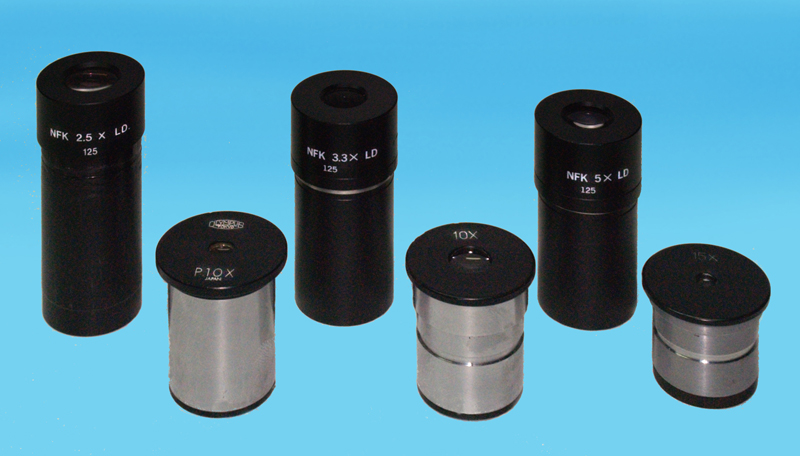
Calibrating Photo Eyepieces on Microscopes
by Michael Reese Much RMS EMS
Bethlehem, Pennsylvania, USA
I recently mounted an exhibition of my extreme macrophotography images of insects at the DaVinci Science Center in Allentown, Pennsylvania and viewers of the exhibit would ask me what the degree of magnification was. That issue had never occurred to me since I was making what I call “scientific fine art photography.” I realized that I would have to have reference points for my images in terms of magnification.
Over the past few years I have acquired a number of what are referred to as photo or projection eyepieces for my microscopes by shopping on ebay. Photo eyepieces differ from conventional eyepieces in that they have fewer optical aberrations and project a flat field of focus to a film plane or digital sensor than is possible using a conventional viewing eyepiece. Photo eyepieces cannot be used for direct visual microscopy.
These are referred to as “relay lenses” in some photomicroscopy literature. The use of conventional 35mm camera lenses as relay lenses will not provide the best imaging because they may produce less than optimal imaging in terms of chromatic aberration, field curvature and pincushion and barrel distortion.
My present collection of relay lenses is shown below:

From left to right: A 2.5X Olympus NFK, an Olympus P 10X, an Olympus 3.3 NFK, an unknown 10X, an Olympus NFK 5X, and an unknown 15X.
The Olympus NFK eyepieces were discontinued about five years ago. From my experience, if they appear on the Internet, snap them up. More details later on the performance of these eyepieces below. One noteworthy feature of these objectives is their relatively large exit pupils, so the images projected onto the sensor are very bright.
Microscope calibration requires a known relative size. This is accomplished with what is known as a “calibration slide” or a “stage micrometer slide.” These can be found on ebay for about $30.00. The calibration slide is used to determine the field of view for your camera with variations in objective and eyepiece magnification. Since all Olympus and Panasonic digital DSLR and Micro Four Thirds cameras use the same sensor size, I can interchange cameras and apply the same field dimensions.
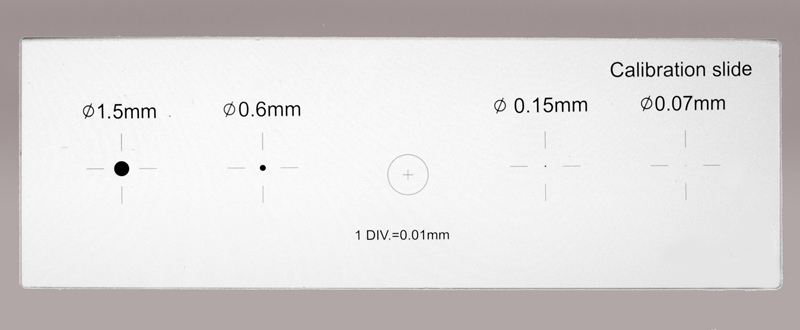
I opted for the slide shown above. The center target is a 1mm XY axis target divided into .01 center-to-center divisions, so each division in the target is 10 microns.
The larger dots can be used to calibrate 2X, 4X and 5X objectives, but since the majority of microscopists use these objectives to do an initial visual survey of a slide, calibrating may not be of importance.
Since the turret on my microscope has four objectives, I had a series of calibration images using my 4X, 10X, 20X, and 40X images like this:
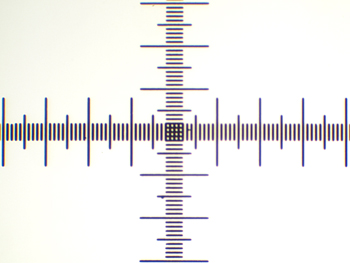
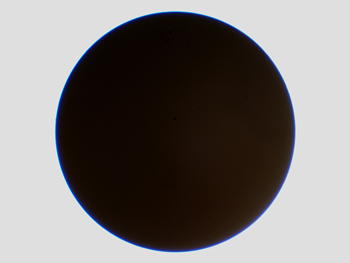
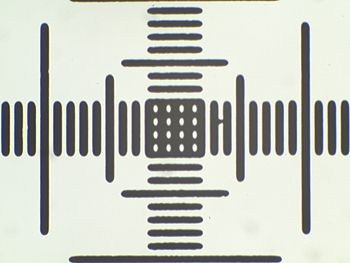
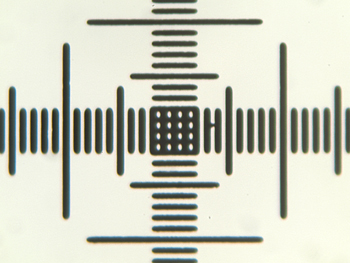
The 1.5 mm dot was used for the 4X objective. The .6 mm dot was used for the 10X and 15X objectives.
The relationship of the field of view to the calibration slide can be measured with a ruler on the computer monitor. Then a table can be created to reference the field of view. The reference table can be applied to refer to the size of the specimen in relation to the field of view.
Once the field of view has been determined in microns for each eyepiece/objective combination, the field of view and the relative size of the specimen can be determined simply by measuring the image with a ruler on a computer screen and doing a simple mathematical interpolation.
After
testing all of these eyepieces I arrived at the following table:
|
Eyepiece |
4X objective |
10X Objective |
20X Objective |
40X Objective |
|
NFK 2.5X |
4.71mm |
1.6mm |
630um |
530um |
|
NFK 3.3 |
3.43mm |
1.23mm |
480um |
400um |
|
NFK 5.0 |
2.19mm |
820um |
320um |
260um |
|
Olympus P10X |
1.71mm |
620um |
240um |
200um |
|
Unknown 10X |
1.8mm |
640um |
250um |
210um |
|
Unknown 15X |
.97mm |
970um |
360um |
120um |
I learned a great deal about my photo eyepieces. For one thing, the Olympus NPKs had the best resolution and contrast. The 5X NPK showed some curvature of field, but it has been noted in photomicroscopy literature that the more conservative 2.5 and 3.3 eyepieces yield the best results. From my tests I would go with the 3.3.
The non-NPK eyepieces were very disappointing and may have gotten by in black and white photomicrography. I found all of these eyepieces to show unacceptable levels of lens flare, barrel and pincushion distortion, contrast, and chromatic aberration
Michael Reese Much can be contacted at this email.
Microscopy UK Front
Page
Micscape
Magazine
Article
Library
Published in the December 2010 edition of Micscape Magazine.
Please report any Web problems or offer general comments to the Micscape Editor .
Micscape is the on-line monthly magazine of the Microscopy UK website at Microscopy-UK .
© Onview.net Ltd, Microscopy-UK, and all contributors 1995 onwards. All rights reserved. Main site is at www.microscopy-uk.org.uk .